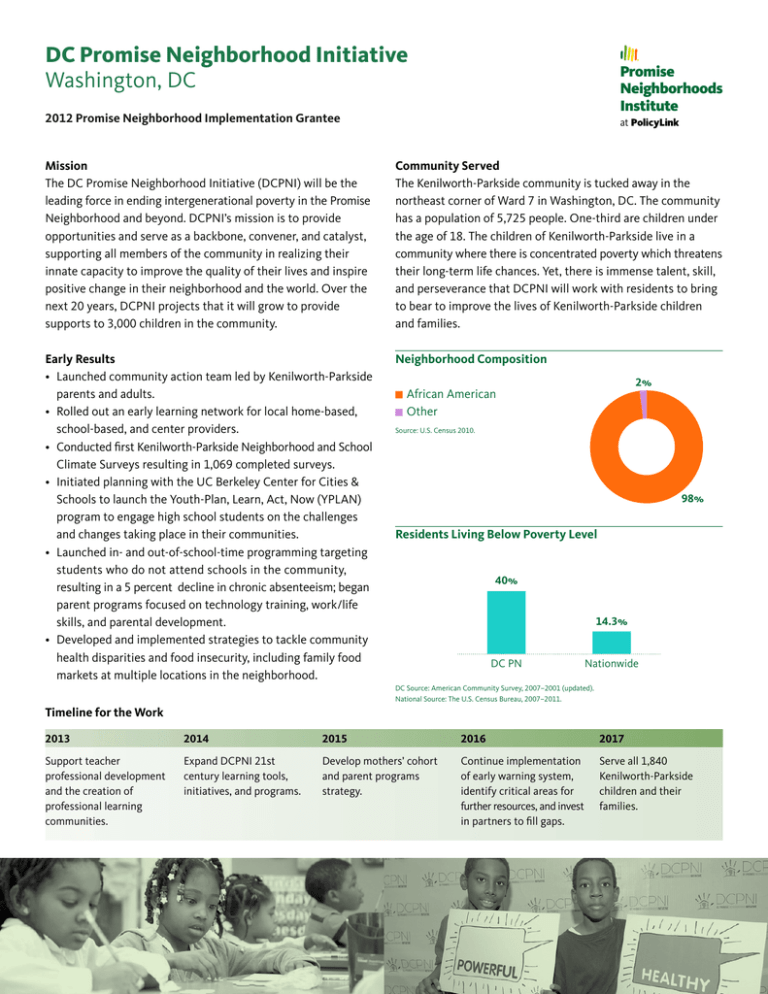
DC Promise Neighborhood Initiative
Washington, DC
Promise
Neighborhoods
Institute
2012 Promise Neighborhood Implementation Grantee
at
Mission
The DC Promise Neighborhood Initiative (DCPNI) will be the
leading force in ending intergenerational poverty in the Promise
Neighborhood and beyond. DCPNI’s mission is to provide
opportunities and serve as a backbone, convener, and catalyst,
supporting all members of the community in realizing their
innate capacity to improve the quality of their lives and inspire
positive change in their neighborhood and the world. Over the
next 20 years, DCPNI projects that it will grow to provide
supports to 3,000 children in the community.
Community Served
The Kenilworth-Parkside community is tucked away in the
northeast corner of Ward 7 in Washington, DC. The community
has a population of 5,725 people. One-third are children under
the age of 18. The children of Kenilworth-Park­side live in a
community where there is concentrated poverty which threatens
their long-term life chances. Yet, there is immense talent, skill,
and perseverance that DCPNI will work with residents to bring
to bear to improve the lives of Kenilworth-Parkside children
and families.
Early Results
• Launched community action team led by Kenilworth-Parkside
parents and adults.
• Rolled out an early learning network for local home-based,
school-based, and center providers.
• Conducted first Kenilworth-Parkside Neighborhood and School
Climate Surveys resulting in 1,069 completed surveys.
• Initiated planning with the UC Berkeley Center for Cities &
Schools to launch the Youth-Plan, Learn, Act, Now (YPLAN)
program to engage high school students on the challenges
and changes taking place in their communities.
• Launched in- and out-of-school-time programming targeting
students who do not attend schools in the community,
resulting in a 5 percent decline in chronic absenteeism; began
parent programs focused on technology training, work/life
skills, and parental development.
• Developed and implemented strategies to tackle community
health disparities and food insecurity, including family food
markets at multiple locations in the neighborhood.
Neighborhood Composition
2%
African American
Other
Source: U.S. Census 2010.
98%
Residents Living Below Poverty Level
40%
14.3%
DC PN
Nationwide
DC Source: American Community Survey, 2007–2001 (updated).
National Source: The U.S. Census Bureau, 2007–2011.
Timeline for the Work
2013
2014
2015
2016
2017
Support teacher
professional development
and the creation of
professional learning
communities.
Expand DCPNI 21st
century learning tools,
initiatives, and programs.
Develop mothers’ cohort
and parent programs
strategy.
Continue implementation
of early warning system,
identify critical areas for
further resources, and invest
in partners to fill gaps.
Serve all 1,840
Kenilworth-Parkside
children and their
families.
Partners
DC Promise Neighborhood Initiative
AARP Experience Corps
America’s Promise Alliance
Capital Area Food Bank
Cesar Chavez Public Charter Schools for Public Policy
City Year
College Success Foundation
DC LISC
DC Primary Care Association
DC Public Schools
DLA Piper/Equal Justice Works/Bread for the City
Dolly Parton’s Imagination Library
East River Family Strengthening Collab­orative
Educare
Georgetown University
Jumpstart
Mentor Foundation USA
Metropolitan Police Department
Neval Thomas Elementary School
Raise DC
Urban Institute
What Is a Promise Neighborhood?
Promise Neighborhoods represent a 20-plus year commitment
by local leaders to create communities of opportunity that allow
children to learn, grow, and succeed. Based on the operating
principles of the Harlem Children’s Zone, Promise Neighborhoods
build partnerships between schools, community organizations,
local businesses, and community members to wrap children
in high-quality, coordinated health, social, community, and
edu­ca­tional support from cradle to career.
About the Promise Neighborhoods Institute at PolicyLink
The Promise Neighborhoods Institute at PolicyLink (PNI) helps
build and sustain Promise Neighborhoods to ensure children
are healthy, succeed in school, reach their full potential, and
that families and neighborhoods support the healthy develop­
ment, academic success, and well-being of their children.
PNI’s system of technical assistance and disciplined approach
moves communities from talk to action by:
• accelerating local leaders’ ability to achieve results;
•building evidence that cradle to career systems are working
across America; and
• supporting leaders’ efforts to scale and sustain results.
From Promise Neighborhood Leaders
“PNI has connected us to resources that helped us understand
the importance of decreasing chronic absenteeism in our
schools, and over the past year we were able to decrease the
percentage of chronically absent elementary students by
5 percent.”
—Isaac Castillo, Deputy Director,
DC Promise Neighborhood Initiative (DCPNI)
www.promiseneighborhoodsinstitute.org
www.policylink.org
© 2014 Promise Neighborhoods Institute at PolicyLink. All rights reserved.
Promise Neighborhoods
Results & Indicators
The Promise Neighborhoods program is one of the most resultsbased and data-driven efforts in America focused on collective
impact. Every Promise Neighborhood works toward making
progress on the same 10 results and 15 indicators through a
mix of solutions and strategies that include families, programs,
policies, and systems.
Promise
Neighborhoods
Institute
at
Table 1. Education Results & Indicators
Results
Indicators
Children enter kindergarten
ready to succeed in school.
•# and % of children birth to kindergarten entry who have a place where they usually go, other than an
emergency room, when they are sick or in need of advice about their health.
•# and % of three-year-olds and children in kindergarten who demonstrate at the beginning of the program
or school year age-appropriate functioning across multiple domains of early learning as determined using
developmentally appropriate early learning measures.
•# and % of children, from birth to kindergarten entry, participating in centerbased or formal home-based early learning settings or programs, which may include Early Head Start,
Head Start, child care, or preschool.
Students are proficient in core
academic subjects.
•# and % of students at or above grade level according to State mathematics and reading or language arts
assessments in at least the grades required by the ESEA (third through eighth and once in high school).
Students successfully transition
from middle school grades to
high school.
• Attendance rate of students in sixth, seventh, eighth, and ninth grade.
Youth graduate from high school.
• Graduation rate.
High school graduates obtain a
postsecondary degree,
certification, or credential.
•# and % of Promise Neighborhood students who graduate with a regular high school diploma and obtain
postsecondary degrees, vocational certificates, or other industry-recognized certifications or credentials
without the need for remediation.
Table 2. Family and Community Results & Indicators
Results
Indicators
Students are healthy.
•# and % of children who participate in at least 60 minutes of moderate to vigorous physical activity daily.
•# & % of children who consume five or more servings of fruits and vegetables daily; or possible third
indicator, to be determined (TBD) by applicant.
Students feel safe at school and
in their community.
•# and % of students who feel safe at school and traveling to and from school, as measured by a school
climate needs assessment; or possible second indicator, TBD by applicant.
Students live in stable
communities.
• Student mobility rate; or possible second indicator, TBD by applicant.
Families and community
members support learning in
Promise Neighborhood schools.
•For children birth to kindergarten entry, the # and % of parents or family members who report that they
read to their child three or more times a week.
•For children in kindergarten through the eighth grade, the # and % of parents or family members who
report encouraging their child to read books outside of school.
•For children in the ninth through twelfth grades, the # and % of parents or family members who report
talking with their child about the importance of college and career; or possible fourth indicator TBD by
applicant.
Students have access to 21st
century learning tools.
•# and % of students who have school and home access (and % of the day they have access) to broadband
Internet and a connected computing device; or possible second indicator TBD by applicant.
Source: U.S. Department of Education



